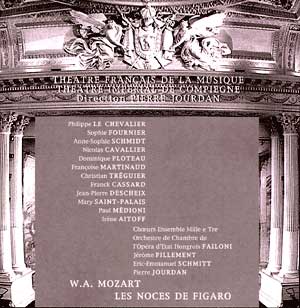Compiègne, to the North-East of Paris is a town
of around seventy thousand people, and is the site of one of the major
Bourbon Royal Palaces of France. Not of the size of Fontainebleau or
Versailles, it was greatly favoured in the 'Second Empire' by Napoleon
III and the Empress Eugénie who used it extensively for entertaining
foreign royalty and the famous, particularly for hunting parties in
the neighbouring extensive forest. In the same forest, in an evocative
clearing, is located the railway carriage in which Maréchal Foch
signed the Armistice of November 1918 thus ending the slaughter of the
Great War.
In 1867 after extensive restoration and re-furnishing
of the palace, the Emperor embarked on the building of the theatre,
but due to the onset of the Franco-Prussian War, in 1870, it was never
finished. In 1987 an association was formed to rehabilitate it and put
on productions. Currently under the artistic direction of Pierre Jourdan,
the attractiveness of the theatre, and its location, draws performances
of quality, some of which have appeared on the 'Chant du Monde' label.
(See review of Auber's Manon Lescaut on the site)
As is often the case in France, with a wish to relate
culture closely with the people, performances are given in French and,
as here, new translations are commissioned. Also, other, what some might
consider rather idiosyncratic practices are adopted so as not to undermine
dramatic credibility. In this case, a first for me, Cherubino (for ease
I will use the Italian standard) is sung by a tenor! None of the foregoing
will be gleaned from the booklet, which limits itself to a cast list,
exposition of the plot and a libretto, all in French. The booklet layout
of the disc contents is somewhat unusual, and would have benefited by
cross-referencing of the track points. The recording is clear and well
balanced in a pleasant airy acoustic, with little stage noise and the
audience applause only intruding in the final bars at the end of each
act'
All the singers give well-studied, vocally satisfying,
performances. At first I thought the Figaro a little gruff, but by 'Se
vuol ballare' he is well into his stride with a pleasant well-rounded
bass tone. The Susanna is suitably spunky. The baritone of the Count,
while being smooth and characterful in his own right, sounds a little
wimpish compared to the Figaro. The Countess has a full toned voice,
but not the clearest diction, in which most of the cast excel. Of course
good diction and expression is much easier in a small theatre and when
the conductor gives space for phrasing and breath. Indeed the pace here
is too languorous at times and sparkle missed. That being said, the
pace is never so slow as to cause the singers difficulty with legato
or the chamber ensemble to lose its vitality or composure. The work
is given complete with all the 'lesser' characters getting their arias.
As for a tenor Cherubino - with a sweet head voice, Ploteau makes a
better case in his first aria than his second, whilst in the recitatives
and dialogue he sounds far too old for a pubescent adolescent. I will
continue to prefer a lyric mezzo, preferably with a shapely leg in her
'trousers' role.
For any French speakers, or those like me who have
visited the sights of Compiègne, this is a pleasant memento;
delightful to listen to and enjoy.
Robert J Farr


